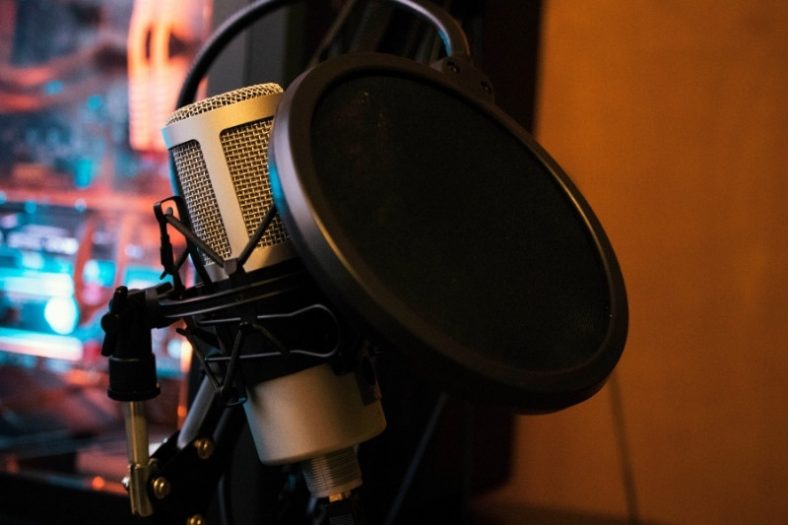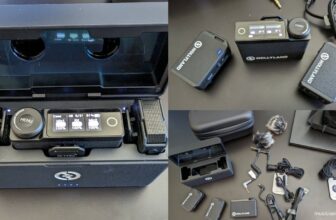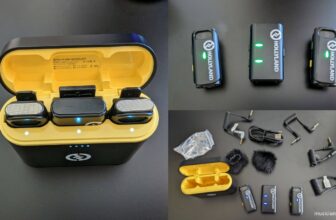What are Pop Filters For?

A pop filter is a circle of thin metal or nylon mesh that stands between the singer and the microphone. Its purpose is to avoid plosives, which are the sounds caused by the blasts of air coming out of your mouth when you pronounce letters such as B’s, P’s, or T’s.
It works by dispersing the air coming out in different directions, so the microphone doesn’t get hit by one big blast of air, which sounds a lot harder while recording than in real life.
Contents
- Are pop filters necessary?
- Do I need a pop filter with a dynamic mic?
- Do I need a pop filter with a condenser mic?
- What can I use instead of a pop filter?
- Are pop filters universal?
- How pop filters work
- What kind of pop filter is best?
- Do streamers use pop filters?
- Windscreen or pop filter for live performance?
- Summary
Are pop filters necessary?
While a pop filter isn’t necessary for your daily life and singing routines, it is definitely worth it in the case you’re recording your vocals and want to have the best sound quality possible.
The air blasts caused by pronouncing letters such as B’s, P’s, or T’s may not sound like a big deal in real life, but your microphone is a piece of gear specifically designed to catch and magnify every bit of sound coming out of your mouth.
Do I need a pop filter with a dynamic mic?
Using a pop filter with a dynamic microphone might not be an absolute necessity. However, it is always better to use one with every kind of microphone available just to guarantee you’re getting the best quality of sound possible.
Do I need a pop filter with a condenser mic?
You should use a pop filter with a condenser microphone as the plosives, which are the air blasts caused by the pronunciation of letters such as B’s, T’s, and P’s, are much harsher on condenser mics due to the proximity effect.
The proximity effect is caused by the low-end sounds coming to the microphone the closer the singer comes to it. As plosives are mostly low-end energy coming out of the singer’s mouth, a pop filter is a must-have if you plan to record your vocals with a condenser microphone.
What can I use instead of a pop filter?
Instead of a pop filter, some people use a sock over the microphones to avoid the air blasts caused by B’s, P’s, and T’s to spoil their vocal recordings. The secret here is using a thin sock that won’t drown out your voice.
Are pop filters universal?
Not all pop filters work the same as they’re not even all made in the same material.
For instance, there are pop filters that feature a single or double layer of nylon mesh, while others hug your particular microphone and are made in thin metallic nets. Pop filters come in different shapes and sizes, and this is why they do not work all in the same way.
How pop filters work
Pop filters are usually a circle-shaped nylon or metal mesh whose objective is to avoid the air blasts caused by the pronunciation of letters such as B’s, P’s, and T’s to spoil the vocals recordings.
Pop filters work by dispersing the air blasts in many different directions, so there’s no single air stream hitting hard on the microphone’s surface.
What kind of pop filter is best?
The best type of pop filter is, without a doubt, the metallic one as it allows a much clearer sound than the nylon mesh ones and also a much more transparent sound than the foam windscreens that come included with many multidirectional microphones that tend to muffle the sound a bit.
On the other hand, metallic pop filters are both more durable, sturdy, and smaller than nylon mesh pop filters, which ensures you that they will last longer and stay out of your way while recording your vocals.
Do streamers use pop filters?
Even if there is some sound benefit derived from the usage of pop filters while streaming, such as the obvious dissipation of plosive sounds, a pop filter can be very uncomfortable and inconvenient for streaming. Because it can be an obstacle to the speaker’s view from a screen or the audience’s view in a live event for example.
Windscreen or pop filter for live performance?
While a pop filter is essential for studio recordings, the truth is a windscreen is a much more suitable choice for your outdoor performances as they block the environmental air currents and general noise that might hit your microphone and distort your vocals.
Windscreens also help protect your microphone from dust and moisture.
Summary
Pop filters are a piece of gear that will help to get a clearer sound out of your vocals while recording in the studio. They prevent plosive sounds like those produced by B’s, P’s, or T’s by dissipating the plosive energy coming from the vocalist’s mouth before hitting the microphone diaphragm.
If you’re on the lookout for one, check out our article on the best pop filters.
Pop filters are especially necessary when they’re meant to be used with a condenser mic. The best type of pop filter you can get is the metallic mesh type. For live performances, it is recommended to use a windscreen rather than a pop filter as they will filter other types of atmospheric noises, while for streaming, the use of pop filters isn’t essential.





